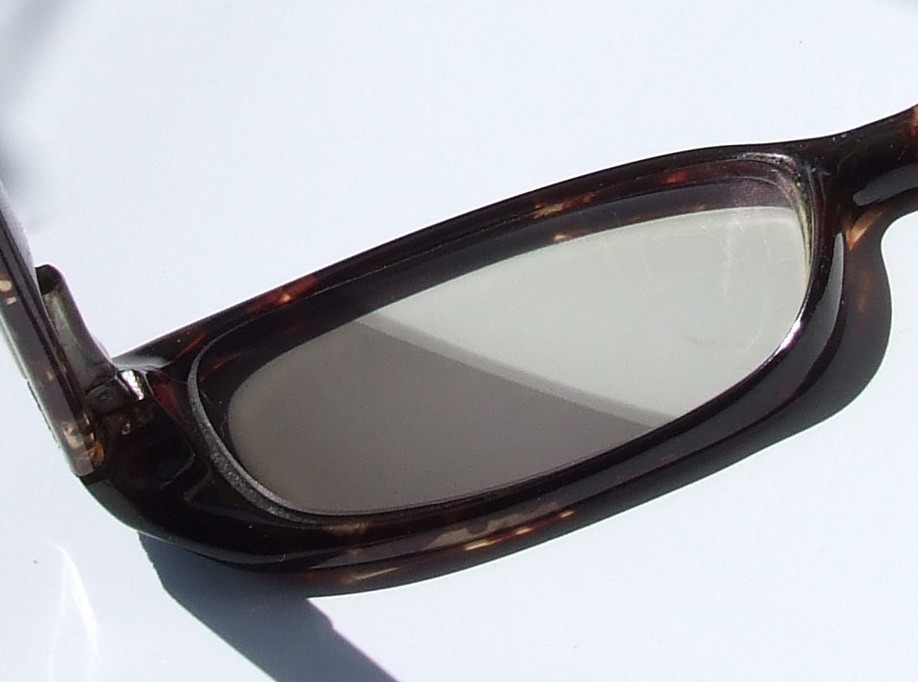Bear in mind that some of the links on this website are affiliate links. If you go through them to make a purchase we will earn a commission at no extra cost to you but helps support our website. Keep in mind that we link these companies and their products because of their quality and not because of the commission we receive from your purchases.
Transition lenses have come a long way since I first started wearing glasses back in the late 90s. Transition lenses are a specific brand for photochromic lenses, which are lenses that automatically adjust to sunlight. Even though Transitions is a specific brand and not the term for these lenses, over the years many eye care professionals have commonly referred to all lenses that are light sensitive as “transitions”.
Table of Contents
Transition Lenses Pros & Cons
These lenses make it more comfortable when you are out in bright sunlight but are clear when you are indoors. You can also find these lenses under the terms, “light-adaptive lenses”, “variable tint lenses”, or “photochromic lenses”.
Back in the day whenever you got photochromic lenses in glass lenses, the molecules that darkened when exposed to UV were embed in the glass material. That meant how dark the lenses got relied on how thick the glass material was. The problem was that prescription lenses have various levels of thickness. This meant that you would have a lens where parts were darker than others. Years later, Transition Optical introduced the plastic photochromic lens in which the molecules were on the surface of the lens, which leads to a more uniform darkening of the lenses.
Over the years photochromic lenses have improved drastically, which has lead to the lenses changing quicker, and becoming darker, as well as being clearer when you are indoors. The lifetime has also increased, I remember when I had my first photochromic lenses they turned yellow after about a year. Today, I have had some backup pairs of glasses that are 3-4 years old and the lenses still work just as good as the day I purchased them.
So in this article, I am going to provide the pros and cons of using photochromic lenses. This isn’t going to be a list of what people generally think about photochromic lenses, but just a first-hand experience from someone who has used these lenses for over 20 years. Let’s us begin.
Pros
There are many great benefits to having photochromic lenses, they do a great job at providing a comfortable viewing experience when you are outside. The automatic darkening makes it seem like the change is seamless when you are going outside, to me it just makes it seem like someone just turned the brightness down on the sun. It is a comfortable and very subtle change, so subtle that you might not even realize that your lenses got dark. So what are the many benefits, let’s dive in:
- Reduces Glare – This has to be the most obvious benefit of having lenses that turn dark. The glare reduction makes it much more comfortable outside when the sun is out, less glare = less eyestrain.
- UV Protection – Photochromic lenses provided constant protection against harmful UV rays from the sun by absorbing 100% of UV-A as well as UV-B.
- Not Carrying Multiple Pairs – This one was a big one for me, it might not be as much of a problem to other people. I hated carrying extra pairs of glasses around. I do have glasses where I do not have photochromic lenses, I do have a reason for it, more on that later. But having to carry a pair of clear glasses and a pair of sunglasses can be a hassle in some situations. For example, if I were to go to a major league sports event such as a football game, or a baseball game. Carrying two pairs of glasses was a hassle, then there’s the chance that you could lose, or damage them when you aren’t wearing them.
- Blue Light Protection – I was thrilled when I learned from a representative from Transition Optical told me that their photochromic lenses block out some harmful blue light indoors as well as outdoors. I personally spend most of my day in front of the computer, outside working out, or on my smartphone. I get exposed to blue light everywhere I turn, so knowing that my glasses filtered out some of the blue light is great.
Cons
This is where you will learn why I always have to keep a backup pair of glasses that do not have transition lenses on them, Don’t get me wrong, I still love my transition lenses but they do have some minor… let’s just call them inconveniences. Alright, where do I start,
- Not Dark Enough – Let’s just start with the number one complained about the issue, they are not dark enough. I felt like they weren’t dark enough when I first started wearing them back in the late 90s. But as technology has developed over the years the lenses are definitely darker. I currently wear the Transitions XTRActive lenses, and they feel dark enough for outdoor use and could almost replace a pair of sunglasses.
- Doesn’t Change In The Car – Next biggest issue, they don’t change in the car. The windshield of your vehicle filters out most of the UV. Therefore photochromic lenses will not change well when you are driving. Transitions, however, has made a lens that also reacts to natural light. Nevertheless, they still aren’t dark enough and do not replace a nice pair of polarized sunglasses for driving during the day.
- Taking Photos Outside – Now this is one of my biggest issues with having photochromic lenses. Whenever you are outside and you want to take a photo, photochromic lenses are always dark whether it is bright and sunny outside, or overcast. Quite annoying, this is one of the reasons why I always have to order a pair of glasses without photochromic lenses.
- They Don’t Change Quick Enough – This wasn’t an issue that I dealt with often, but when the situation came up it was a bit annoying. If you are doing something where you are constantly walking indoors and outdoors, the lenses are never clear. This could be problematic if you walk indoors into a low light setting.
Would I Recommend Photochromic Lenses?
Well, this question isn’t necessarily a yes or no question. When I worked as an optician and I was helping you with your eyeglass order, whether or not I recommended you to get photochromic lenses would be largely based off of what you did for work, or enjoyed to do on your free time. If you spent a lot of time outdoors or worked outdoors you could benefit from having photochromic lenses. 
You really have to be someone that spends a bit of time outdoors to benefit from having photochromic lenses. If you work an overnight shift, and the only sunlight you get is the distance from your front door to your car, then there really isn’t any point to getting photochromic lenses.
I personally love my photochromic lenses, I do keep a pair of polarized prescription sunglasses in my car that I could use for driving. There is truly nothing that could replace a polarized pair of sunglasses for driving. Even for some recreational activities such as fishing, it would be more beneficial to have polarized sunglasses to cut down the glare from the water surface.
Final Thoughts
Are they worth it? To me, I thought they are worth the extra money. Especially if you are someone that wears prescription glasses and you like to go to sporting events or spend time outdoors. They can provide a very comfortable viewing experience by cutting down the glare from the sun. There may be a few inconveniences but, they aren’t that much of an inconvenience to be a deal breaker.
If you have any further questions about transitions, feel free to drop a comment below, and I will get back to you as soon as possible.
